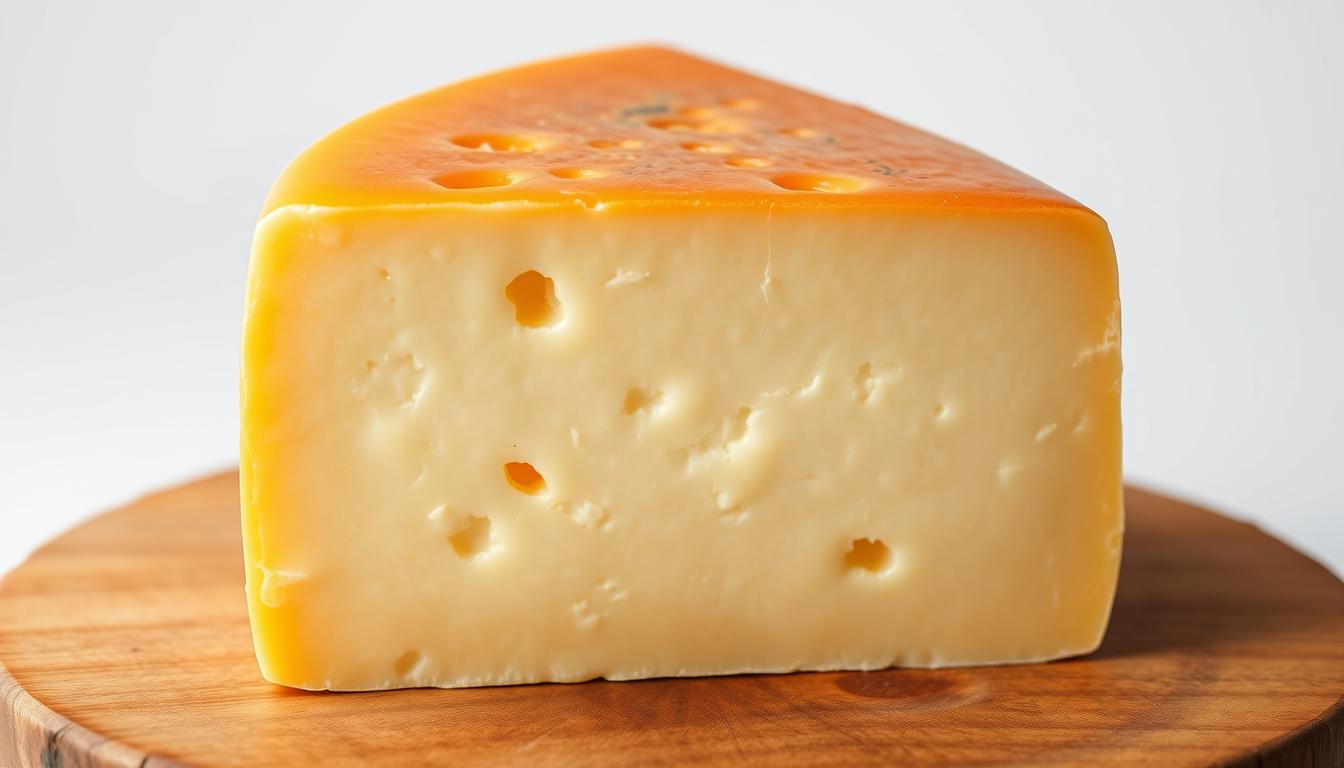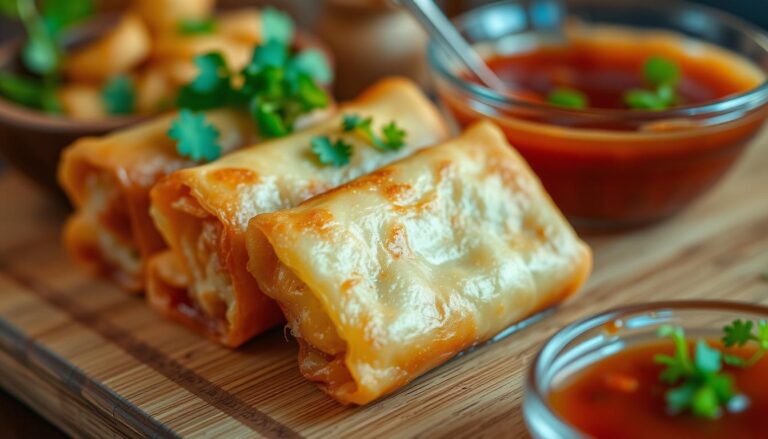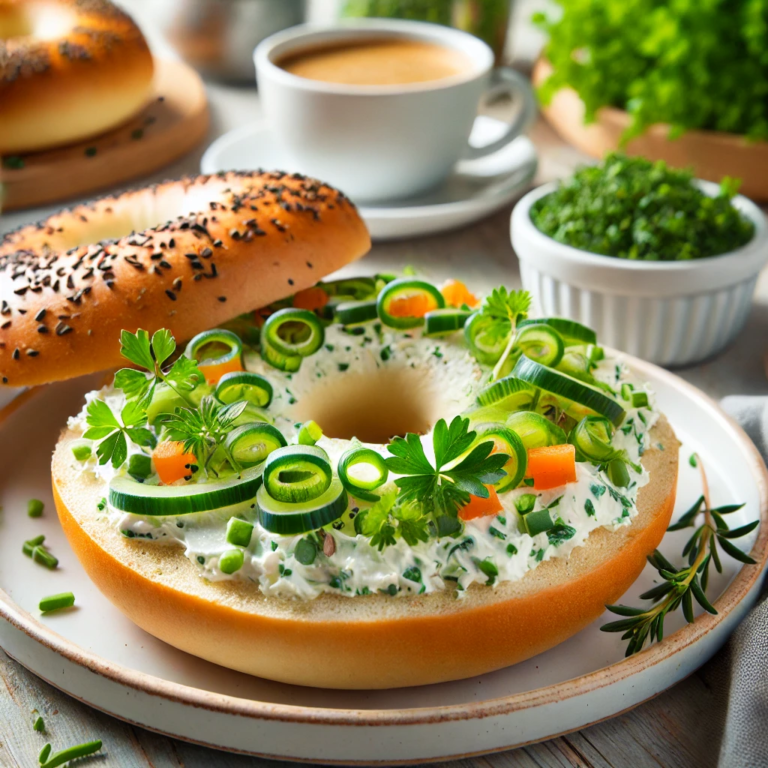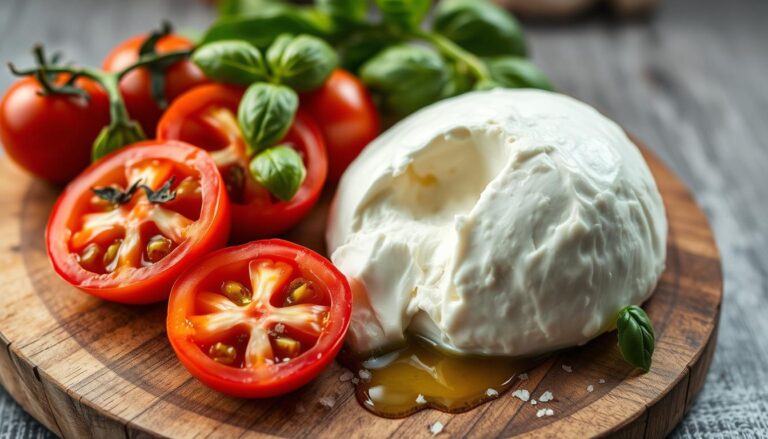Fontina Cheese: The Flavorful Staple for Your Kitchen
Fontina cheese has a long history in Italian cooking, starting in the 12th century. It comes from the Valle d’Aosta mountains in northwestern Italy1. This cheese is loved for its nutty taste and smooth texture, making it perfect for many dishes. It’s a cheese that has been enjoyed for centuries and is now popular all over the world.
Whether you’re new to gourmet food or already love cheese, Fontina is worth trying. It has been protected since 1992, showing its importance in Italian food1. Knowing its history and importance helps you see its value in cooking. Fontina is great for many dishes, from starters to main courses.
Key Takeaways
- Fontina cheese has a rich history in Italian culinary culture, dating back to the 12th century1.
- Fontina is a staple in many kitchens, known for its nutty flavor and smooth texture.
- What is Fontina Cheese? It is a type of cheese that has been enjoyed for centuries.
- Fontina cheese holds a special place in Italian cuisine with its Protected Designation of Origin (PDO) status since 19921.
- Fontina is a versatile cheese that can be used in a variety of dishes, from appetizers to main courses.
- Italian Fontina is a popular choice among cheese lovers, and its popularity has spread worldwide.
- Fontina cheese can be paired with various wines, including Italian red wines made from the Nebbiolo grape2.
What is Fontina Cheese?
Fontina cheese is a semi-soft, mild to medium-sharp cheese with a rich history. It comes from the Aosta Valley in Italy. It’s made from unpasteurized cow’s milk, with about 45% fat3.
It’s aged for 90 to 150 days, which adds a unique flavor. This flavor has notes of nuttiness3.
Fontina cheese has a milder flavor and a softer texture compared to Gruyère4. Italian Fontina is known for its stronger flavor and denser texture. The Aosta Valley has strict rules for making Fontina. It must be made from unpasteurized milk from a single milking, with two batches per day4.
The taste of Fontina cheese is mild to medium-sharp. It has a nutty flavor that gets stronger with age4. Its texture is semi-soft, with a tan to orange-brown rind and a pale cream interior. It has holes called “eyes”4.
Fontina cheese is often used in traditional dishes. One example is Fonduta alla valdostana, a fondue made with Fontina, milk, and eggs4.
- Country of origin: Italy
- Region: Aosta Valley
- Source of milk: Cows
- Pasteurized: No
- Texture: Semi-soft
- Fat content: 45%
Fontina cheese has been made since the 12th century. It has EU PDO certification since 19964. Comparing it to Gruyère and Italian vs Danish Fontina shows each cheese’s unique qualities. These qualities make them perfect for different dishes4.
The Distinctive Characteristics of Fontina
Fontina cheese is famous for its mild, nutty taste and smooth feel. It’s great for many dishes, from starters to main courses, including the Best Fontina Cheese Recipes. Its flavor is salty, sweet, and nutty, perfect for melting in dishes like polenta and homemade pizza5.
The Fontina Cheese Texture is creamy and smooth, loved by both chefs and home cooks. There are four types of Fontina cheese: d’Aosta DOP, Scandinavian, non-DOP Italian, and American5. Each type has its own special traits, with d’Aosta DOP made only in the Aosta Valley using milk from Aosta Valley cows5.
The aging time affects Fontina Cheese Taste and Texture a lot. DOP d’Aosta fontina ages for about three months5. This aging helps create the cheese’s unique flavor and texture, making it essential in many Best Fontina Cheese Recipes.
Fontina cheese’s special qualities make it a favorite in cooking. Its unique taste and texture have made it a staple in many Best Fontina Cheese Recipes5.
Italian Fontina vs Danish Fontina: Understanding the Differences
Italian and Danish Fontina cheeses have their own unique qualities. Italian Fontina has a stronger taste than Danish Fontina, which is milder6. Also, Italian Fontina is denser in texture. Knowing these differences is key to How to Melt Fontina Cheese right.
Italian Fontina tastes more intense, while Danish Fontina is lighter and sweeter7. This makes Italian Fontina perfect for Fontina Cheese for Fondue. Danish Fontina, with its softer texture, melts better6.
Here are some key differences between Italian and Danish Fontina:
- Flavor: Italian Fontina has a more robust flavor, while Danish Fontina is milder
- Texture: Italian Fontina is denser, while Danish Fontina is softer
- Uses in cooking: Italian Fontina is ideal for fondue, while Danish Fontina is better suited for melting
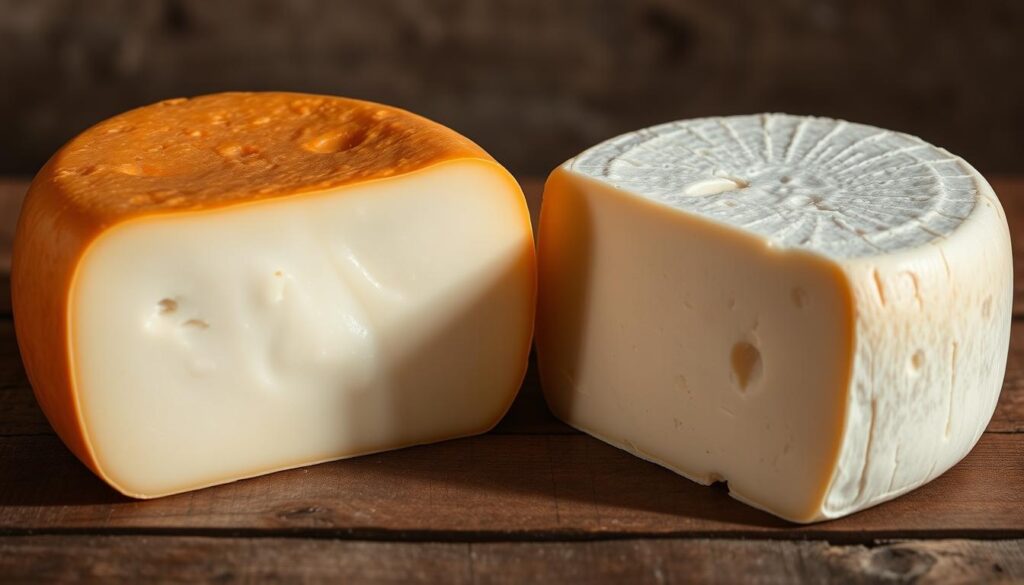
Knowing these differences helps you pick the right Fontina for your recipes. Whether it’s for fondue or another dish, the right choice will make your food taste and feel better8.
Nutritional Benefits of Fontina Cheese
Fontina cheese is packed with nutrients like protein, calcium, and more. A 100-gram serving has about 390 calories, 25 grams of protein, and 31 grams of fat. Of that fat, 20 grams are saturated9. It also has a lot of calcium and phosphorous, with half an ounce giving you nearly 20% of your daily calcium needs9. Plus, it’s full of vitamins A, K, and B12, which are good for your heart9.
When you think about Fontina Cheese Nutrition, remember it’s okay in small amounts. It’s been used to help with stomach problems like constipation and diarrhea9. Studies show that eating enough calcium can help prevent osteoporosis9. The calcium and phosphorous in fontina cheese also help with nerve function and keeping your energy up9.
Some of the key nutrients in fontina cheese include:
- Protein: 26g10
- Calcium: 550.0mg, contributing to 42% of the Daily Value (DV)10
- Vitamin D: 23.0 IU, contributing to 3% of the DV10
- Phosphorus: 346.0mg, contributing to 34% of the DV10
As a Healthy Cheese Option, fontina cheese is great for a balanced diet. Its rich nutrients and health benefits make it a smart choice for adding to your meals.
How to Store and Serve Fontina
Storing Fontina Cheese right is key. Keep it in a cool, dry spot, wrapped in cheese paper or foil11. This keeps the cheese fresh and prevents it from picking up bad smells from other foods11. For the best taste, serve it at room temperature12.
To store it, wrap it loosely in paper and then in plastic wrap. Or, keep it in a damp cellar at 50 to 53 degrees Fahrenheit12. Make sure to keep it away from strong smells and clean your fridge often to avoid mold11.
When serving, pair it with dry white wines like Chardonnay or Sauvignon Blanc for a great taste13. Light red wines, like Pinot Noir, also go well with Fontina13. Add thyme, rosemary, mushrooms, and caramelized onions for extra flavor13.
For more cheese tips, check out cheesevibes.com. They have lots of info on storing and serving different cheeses.
| Cheese Type | Storage Method |
|---|---|
| Fontina | Loosely wrapped in paper and plastic wrap |
| Hard Cheeses | Tightly wrapped in paper and plastic |
| Soft Ripened Cheeses | Loosely wrapped in paper and stored in a partially sealed plastic bag |
Cooking with Fontina: Tips and Techniques
Cooking with Fontina cheese is a joy. It’s great for pasta, pizza, and risotto14. Its melting quality makes it perfect for sauces and baked goods. To get the best flavor, mix it with herbs and spices.
Start with a classic Italian dish like lasagna from cheesevibes.com. It shows how Fontina cheese works well with garlic and thyme14. Fontina is also key in roasted garlic pull-apart cheese bread and asparagus and two-cheese quiche15.
When cooking with Fontina, mix it with other cheeses like parmesan or mozzarella. Don’t overcook it, as it can lose its texture. With these tips, you’ll make dishes that wow everyone.
Here are some popular Fontina recipes to try:
- Roasted garlic pull-apart cheese bread
- Asparagus and two-cheese quiche
- Carrot pizza with Fontina and red onion
These recipes show how versatile Fontina cheese is. It’s great for everything from appetizers to main dishes15.
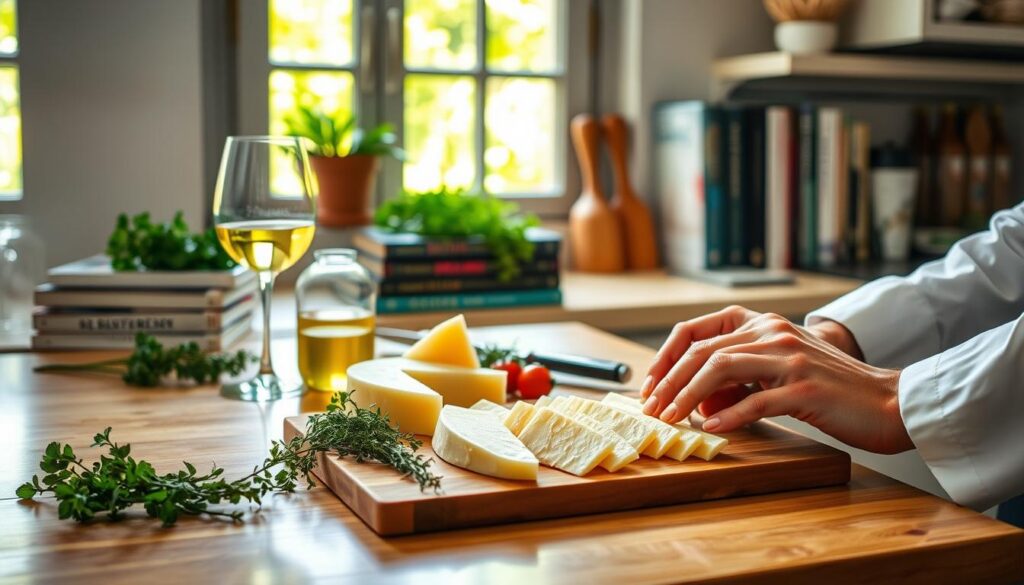
Popular Fontina Cheese Recipes
Fontina cheese is great for many dishes, from classic Italian to modern recipes. For Easy Fontina Recipes, there are lots of choices. Try the Italian “Stuffed” Toast, with Fontina cheese as the star16. It’s perfect for a quick snack or appetizer.
Other favorites include Chicken Valdostano and Cheesy Tots. They show off Fontina’s meltability and flavor. For something new, try it in a grilled cheese or on top of cheese fondue17.
Fontina cheese is versatile and delicious. It’s a must-have in many Italian kitchens. Whether you’re making something simple or complex, Fontina is a great choice. It has a prep time of 10 minutes, a cook time of 6 minutes, and a total time of 16 minutes18.
Here are some key nutritional facts for Fontina cheese in your recipes:
- Calories per serving: 597 kcal18
- Carbohydrates per serving: 19 g18
- Protein per serving: 32 g18
- Fat per serving: 43 g18
These facts show why Fontina cheese is good in many dishes, from Easy Fontina Recipes to more complex meals.
Substitutes for Fontina in Cooking
Looking for substitutes for Fontina? Several cheeses offer a similar taste. Cheese substitutions can be tricky, but knowing each cheese’s traits helps. Gruyère and Emmental are great substitutes, with a nutty and sweet taste19. Mozzarella works well for a younger Fontina, with a milder flavor19.
Other Substitutes for Fontina include Provolone, Parmesan, and Cheddar. Provolone gets tangier with age, perfect for many dishes19. Parmesan’s sharp, dense texture makes it a good Fontina substitute19. Edam and Taleggio offer unique flavors and textures19.
For a vegan option, try nutritional yeast and firm tofu. They mimic cheese’s cheesy taste20. Remember, the best Fontina substitute depends on your recipe and taste goals. Knowing each cheese’s characteristics helps you choose the right Cheese Substitutions20.
Here’s a list of popular Fontina substitutes:
- Gruyère
- Emmental
- Mozzarella
- Provolone
- Parmesan
- Edam
- Taleggio
Conclusion: Embracing Fontina’s Versatility in Your Kitchen
Fontina cheese is a treasure for every kitchen. It has a rich history and a unique taste. This northern Italian cheese is perfect for creative cooking. Explore Fontina’s diverse applications, from classic Italian dishes to modern fusion recipes. It can make your cooking better21.
Fontina is great for many dishes. You can melt it in pasta sauce, use it in panini, or feature it on a cheese board. Its special taste will excite your senses. Let Fontina inspire you to try new things in the kitchen22.
Keep exploring Fontina cheese and its possibilities. The secret to enjoying it fully is to be open to new experiences. Let Fontina’s versatility lead you to create amazing dishes21.

